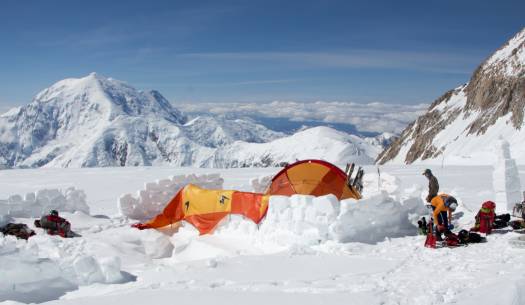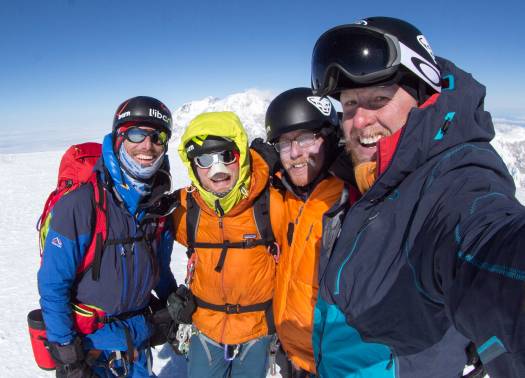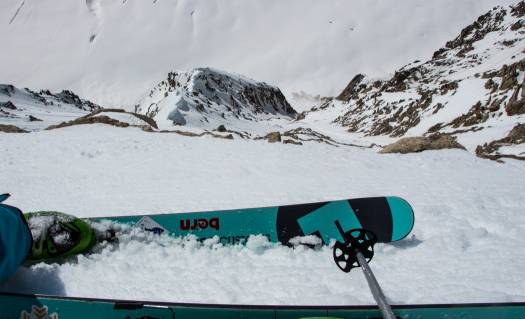Welcome to the Kahiltna Glacier. There is hot time, there is cold time, and there is in-between time. There is sun to cook you like a deep fried Twinkie — and storms to make you so cold you begin to wonder why in the heck you chose to come to a place like this. To handle such radical swings in conditions, you need the right gear, and when it comes down to it, the right gear seems to be a rather large pile of stuff:
For the majority of my outerwear clothing needs I used the Oakley outerwear that I have been skiing in for the year. Outside of the summit of Denali, my outermost layer when it was cold and windy was the Beltline jacket and pants. Both are made from 3 layer Gore-Tex, and have enough pockets to lose that lighter for the 3rd time today. I did size up however for this mission as I wanted to be able to put an obscene amount of layers underneath my shell.
Easily my favorite jacket on the trip though, is a Windstopper softshell jacket from Oakley that I have had for a couple years, which is still going strong. For the constant flux of temp it is the perfect top layer. I strongly recommend that a softshell jacket be part of your arsenal for almost any trip into the snowy parts of Alaska. Sometimes you’ll need more, but the temperature range of softshell type jackets is incredibly useful. The next layer down for me is an Oakley Polartec fleece insulator that is a great mid layer, or even an outerlayer when it happens to not be windy, though this is rare in the Alaska Range.
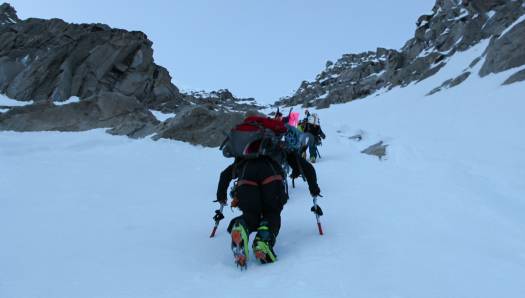
Much of the gear pile in haul mode. In Alaska you don’t hire Sherpas, you are the Sherpa. That’s somewhat unique (many if not most of the big peaks in the world are usually climbed with the assistance of porters), and thus requires extra thought as to how big and heavy the pile is.
One thing often overlooked for trips like this is what kind of base layers to bring. True, most will work, but there are some that are better than others for multiple reasons. I’m a big fan of anything made of Merino wool and I took a lot of it. Number one reason for choosing Merino over synthetics is that the wool doesn’t capture smell quite as bad. When you don’t plan on scrubbing those armpits for weeks on end, this is important to yourself as well as your tentmates. At all times on this trip I had on a short sleeve Merino wool tee shirt. Many companies make them, and I took three for the whole trip. I tend to go for the lightest, thinnest one a company has for this. Ditto for long johns. Mine were all Merino wool of varying thicknesses.
My down pants by Western Mountaineering have been around for more than just a couple expeditions. Our down pants became known as our happy place when we got back from cold days on the hill. I have a
Primaloft insulated Beltline jacket from Oakley as well that compresses rather small, and is super warm, and I’m not particularly worried about getting it wet. It was my main warm jacket for the entire trip, as often the expedition parka is just a bit too much.
I brought along the huge North Face Himalayan parka from our WildSnow Denali trip in 2010, but I only put it on twice before the summit of Denali: once in our “shiver bivy” trip on Hunter and once in the wind outside of camp on Foraker. Save for our Denali summit day it just wasn’t THAT cold. Indeed, the North Face Himalayan is bulky and heavy, it is designed to be worn constantly as a combined outer layer and insulating layer at high altitudes; a classic baffled 100% down jacket, still thick but without synthetic insulation and with lighter weight fabric, is perhaps more versatile for Denali, saving both weight and bulk.
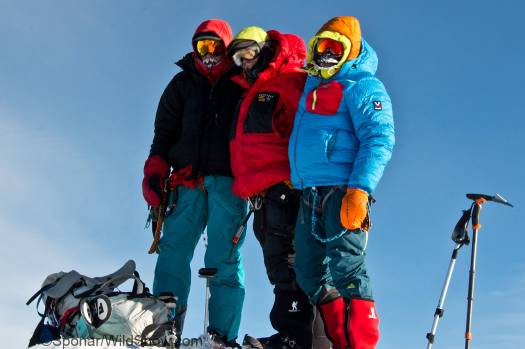
Denali Summit. Cold. Me at left wearing North Face Himalaya, the other guys have what are perhaps more versatile and lighter weight parkas. It is challenging to bring gear on Denali that works for the warmer days down low, and converts to an integrated system for your summit day. Practice at home.
The main item I’ve found on my hands is a pair of $10 Kinkos that I snow sealed right before I left. For the colder days of climbing and skiing my next step up is my Hestra Heli gloves that are still going strong from WildSnow Denali last time. When it really gets cold out and/or I’m stuck in a shiver bivy my Outdoor Research Alti Mitts that I bought before going to Mount Elbrus 6+ years ago keep my hands about as warm as I can stand.
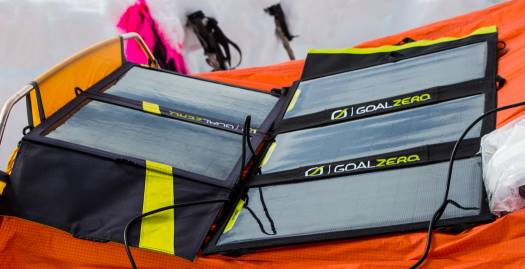
Goal Zero PV worked well. A variety of options for panels and battery packs makes it easy to tune a setup for your exact requirements.
I have an Oakley balaclava that has done the trick along with a Folsom Skis beanie, and Folsom skis Trucker hat (more breathable). My brain bucket has been a Bern Watts EPS helmet.
Most nights I’ve been sleeping in a Black Diamond beanie that I can pull down over my eyes to sleep since it’s always light out. This time around I opted to give the Western Mountaineering expedition down booties
a try; they have been great. They come up to just below the knee, and allow for a bit more around camp activity without filling them with snow. I generally go for Merino whenever possible to cut down a bit on smell, and socks were no change here. Darn Tough Merino ski socks were my choice for this entire trip save for an old pair of super thick Patagonia mountaineering socks for around camp.
I have a pair of Julbo glacier glasses that I’ve been swapping back and forth with my Oakley Crankshaft sunglasses and my Oakley Canopy goggles to protect my eyes.
Dermatone is the sunscreen of choice out here for me, and I’m starting to question whether my face can absorb any more of it at this point.
My ski gear is rather straightforward: I have a pair of Folsom MTX skis that are simply the best all around ski mountaineering ski I have been on thus far; they are 180 which is shorter than I would normally ski, but at 132-100-120 and with at turn radius of 23 meters they have plenty of sidecut to handle some of the insanely bad ski conditions we’ve dealt with and they float well when we have the snow to have lots of fun. They weigh in at 3lbs 9oz (1750 grams). Pretty light considering they are burly on the downhill.
They are mounted with a pair of Dynafit Radical FT bindings which are as light duty as someone my size should be willing to go for on an expedition like this in my opinion.
BD ascension skins were the clear choice for me with all of the steep skinning and sled hauling. Their new style glides better than before, and grips insanely well.
On top of that I’m clicking in with a pair of up sized Dynafit Vulcans. This boot for most people is a perfect freeride boot, but for me I like them as my ski mountaineering boot because they walk incredibly well and ski even better on the downhill. In my opinion the only way to go is Intuition liners to make my feet warm and comfortable; no performance fit needed here, I want my feet warm.
And the last layer of cold protection here is the 40 below Fresh Tracks over-boots. After a bit of modification, I can skin, crampon, and ski without taking them off, a truly warm option. Of course I’m sporting the same Black Diamond Whippets as last time I was here. One addition to this trip has been a pair of BD Venom axes. They have come in incredibly handy so far on Hunter where we used their ice tool side an insane amount. I’m still using my same 40 Below water bottle covers that I purchased last time, and they still work as well as they did before, just a bit dirtier, along with the GSI Fair Share and 40 below insulator for that. I brought along the GSI French press system, and that has been great on down days and go days alike.
I brought the same trusty Thermarest Prolight Plus pad as last time and a -25 Western Mountaineering Puma bag as -40 was just too much during our 2010 trip. Oh and my one real luxury item has been an Exped air pillow.
(‘Ski The Big 3 was an Alaskan ski mountaineering expedition cooked up by four deprived (or perhaps depraved?) guys who never get enough ski and snowboard alpinism. Aaron Diamond, Evan Pletcher, Anton Sponar, Jordan White. The idea was to ski Denali, Mount Foraker, and Mount Hunter all during one expedition — which they did during spring of 2014 — much to the amazed delight of the ski mountaineering community.)
Jordan White is a strong alpinist who finished skiing all 54 Colorado 14,000 foot peaks in 2009. He guides, tends bar, and lives the all-around perfect life in Aspen.

